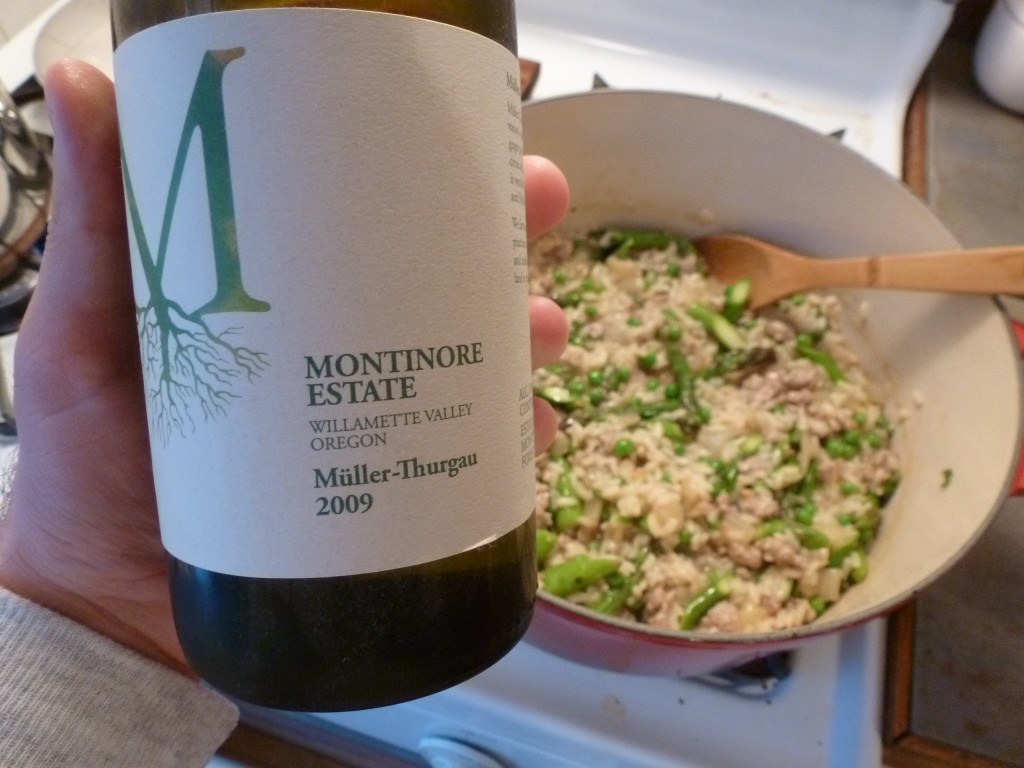Beyond Flaccid Sugarwater
 Müller-Thurgau’s German origins haven’t done the variety any favors. I remember it well from the year I spent living in Freiburg, where bottles of the stuff would sell for about $3, with $3 flavors to match. German Müller-Thurgau incites thinly veiled feelings of revulsion in noted wine critic Jancis Robinson, whose entry about the grape in The Oxford Companion to Wine reads like a review of a Michael Moore documentary: “fat, flaccid… too often with a slight suspicion of rot… extremely dull, flabby… thin-skinned…”
Müller-Thurgau’s German origins haven’t done the variety any favors. I remember it well from the year I spent living in Freiburg, where bottles of the stuff would sell for about $3, with $3 flavors to match. German Müller-Thurgau incites thinly veiled feelings of revulsion in noted wine critic Jancis Robinson, whose entry about the grape in The Oxford Companion to Wine reads like a review of a Michael Moore documentary: “fat, flaccid… too often with a slight suspicion of rot… extremely dull, flabby… thin-skinned…”
Dr. Hermann Müller, born in the northern Swiss canton of Thurgau, created the variety in 1882, hoping to combine the nuances and flavors of Riesling with the early-ripening characteristics of Silvaner (itself an old hybrid of Traminer and Österreichisch Weiss). But according to recent DNA profiling, the Companion notes, Müller-Thurgau is actually a cross of Riesling and Madeleine Royale, a simple table grape (a grape intended to be eaten as fruit). Whoops.
Although Müller-Thurgau produces “oceans of sugarwater” in Germany, the variety “can be much more exciting” outside its Teutonic homeland. According to this 2006 article by wine critics Dorothy Gaiter and John Brecher, the “gold standard” of Müller-Thurgau comes from Italy’s northern Trentino-Alto Adige region. They tried a $36 Kofererhof Müller-Thurgau in a New York restaurant, giving it high marks: “Flinty, with some melons and dirt but brighter than we had expected. Earthy but not heavy, with real vitality. Surprisingly juicy, with some white pepper.” (Unfortunately, the sommelier looked at them like they’d ordered a bottle of Blue Nun and avoided their table the rest of the evening.)
The Companion agrees about Alto Adige, and also cites Oregon as promising Müller-Thurgau territory. A bottle of 2009 Montinore Estate Müller-Thurgau I found from Oregon’s Willamette Valley didn’t quite reach the lofty heights of the Kofererhof, but it certainly rose above German sugarwater.
This Müller-Thurgau smelled to me like very ripe pears. On the tongue, for a moment it just tasted like apple juice. Uh-oh. But then I felt the prickle of some acids, and the wine pulled itself together with a satisfyingly tart finish. It wasn’t the “revelation” that the Kofererhof had been for Gaiter and Brecher, but certainly I enjoyed drinking it. Paired with a spring risotto with peas, asparagus and baby artichokes, the acids became even more prominent, cutting through the richness of the dish.
I love to see serious wineries like Montinore experimenting with this oddly named variety with a bad reputation. We wine drinkers stand to gain much from their risk-taking. Müller-Thurgau may not flourish in Germany, but if you see one from Oregon or Italy, grab it. Your sommelier might look askance, but you’ll know better.
SUMMARY
2009 Montinore Estate Müller-Thurgau: Starts sweet, but the sugars are balanced by food-friendly acids. A fine pairing with risotto, pastas with cream-based sauces or lightly spicy Asian dishes. Serve well-chilled.
Grade: B
Find It: I purchased this bottle for $12 at In Fine Spirits, which isn’t carrying the wine as of this writing. The Montinore website offers the 2011 vintage for sale for $16.





